Study on the Performance of Epoxy-Modified Asphalt and Steel Slag Ultra-Thin Friction Course
Abstract
1. Introduction
2. Materials and Methods
2.1. Materials
2.1.1. Asphalt
2.1.2. Epoxy Resin
2.1.3. Aggregate Sand Fillers
2.2. Sample Preparation
2.2.1. Preparation of Epoxy-Modified Bitumen
2.2.2. Preparation of the Asphalt Mixtures
2.3. Test Methods
2.3.1. Fourier Transform Infrared Spectroscopy
2.3.2. Fluorescence Microscopy Test
2.3.3. Differential Scanning Calorimetry Test
2.3.4. Asphalt Testing
2.3.5. Asphalt Mixture Performance Testing
3. Results and Discussion
3.1. Mechanistic Analysis of Epoxy Resin and Modified Bitumen
3.1.1. Epoxy Asphat Microstructure
3.1.2. Physical Properties of EA
3.1.3. Rheological Properties of EA
3.2. Study EA’s Curing Behavior
3.2.1. Study EA’s Curing Temperature
3.2.2. Study EA’s Curing Process of Viscosity
3.2.3. Study EA’s Curing Process over Time
- —The characteristic peak area of the epoxy group at time t;
- —The characteristic peak area of the epoxy group at the beginning;
- —Characteristic peak area of the benzene ring group at time t;
- —Characteristic peak area of the benzene ring group at the beginning;
- —Epoxy group conversion at t,%;
- —Epoxy group conversion at 24 h,%;
- —Curing degree of EA at t,%
3.3. EUTOL Pavement Performance
3.3.1. Skid-Resistance Durability
3.3.2. High-Temperature Performance
3.3.3. Low-Temperature Performance
3.3.4. Water Stability Performance
3.3.5. Fatigue Performance
4. Conclusions
- The results of fluorescence analysis experiments show that the particle size of epoxy resin particles gradually becomes larger when the EA dosage increases. However, when the EA content exceeds 40%, the epoxy resin particles undergo agglomeration behavior, decreasing the area share of the epoxy resin particles.
- The doping of the epoxy resin significantly increased the EA’s softening point but decreased the EA’s needle penetration and ductility.
- 3.
- DSC and FILT experiments showed that the EA cured at 94 °C to 114 °C. The EA was cured at 120 °C in three phases.
- 4.
- The viscosity–time curve shows. At 150°, UTOL prepared with 40% EA has sufficient time for construction processes such as transportation, paving, and compaction.
- 5.
- Using steel slag coarse aggregate instead of natural coarse aggregate improves the slip resistance, high-temperature performance, low-temperature performance, water stability, and durability of EUTOL. At the same time, using steel slag fine aggregate reduced the performance of EUTOL.
Author Contributions
Funding
Institutional Review Board Statement
Informed Consent Statement
Data Availability Statement
Conflicts of Interest
References
- Li, Q.; Shen, A.; Guo, Y.; Wu, J.; Shi, Y. Review of Evaluating Asphalt Pavement Structure Integrity and Strength with Rayleigh Wave Methods: Techniques, Applications, and Trends. Measurement 2024, 234, 114849. [Google Scholar] [CrossRef]
- Pipintakos, G.; Sreeram, A.; Mirwald, J.; Bhasin, A. Engineering Bitumen for Future Asphalt Pavements: A Review of Chemistry, Structure and Rheology. Mater. Des. 2024, 244, 113157. [Google Scholar] [CrossRef]
- Yang, C.; Wu, S.; Cui, P.; Amirkhanian, S.; Zhao, Z.; Wang, F.; Zhang, L.; Wei, M.; Zhou, X.; Xie, J. Performance Characterization and Enhancement Mechanism of Recycled Asphalt Mixtures Involving High RAP Content and Steel Slag. J. Clean. Prod. 2022, 336, 130484. [Google Scholar] [CrossRef]
- Xu, H.; Zou, Y.; Airey, G.; Wang, H.; Zhang, H.; Wu, S.; Chen, A. Wetting of Bio-Rejuvenator Nanodroplets on Bitumen: A Molecular Dynamics Investigation. J. Clean. Prod. 2024, 444, 141140. [Google Scholar] [CrossRef]
- World Steel Association. Steel Statistical Yearbook 2023; World Steel Association: Brussels, Belgium, 2024. [Google Scholar]
- Guo, M.; Zhang, R.; Du, X.; Liu, P. A State-of-the-Art Review on the Functionality of Ultra-Thin Overlays Towards a Future Low Carbon Road Maintenance. Engineering 2024, 32, 82–98. [Google Scholar] [CrossRef]
- Abaza, K.A.; Ashur, S.A. Optimum Decision Policy for Management of Pavement Maintenance and Rehabilitation. Transp. Res. Rec. 1999, 1655, 8–15. [Google Scholar] [CrossRef]
- Xie, J.; Chen, J.; Hu, L.; Wu, S.; Wang, Z.; Li, M.; Yang, C. Preparation, Thermochromic Properties and Temperature Controlling Ability of Novel Pellets in Ultra-Thin Wearing Course. Constr. Build. Mater. 2023, 389, 131797. [Google Scholar] [CrossRef]
- Wang, J.; Sun, J.; Luo, S.; Li, Q. Laboratory and Field Performance Evaluation of High-Workability Ultra-Thin Asphalt Overlays. Materials 2022, 15, 2123. [Google Scholar] [CrossRef]
- Ding, L.; Wang, X.; Zhang, K.; Zhang, M.; Yang, J.; Chen, Z. Durability Evaluation of Easy Compaction and High-Durability Ultra-Thin Overlay. Constr. Build. Mater. 2021, 302, 124407. [Google Scholar] [CrossRef]
- Fan, Z.; Wang, C.; Li, Y.; Feng, L.; Chen, Q. State of the Art Review on Fog Seal for Asphalt Pavement: Material Composition, Classification, Performance Evaluation, and Mechanism Analysis. Prog. Org. Coat. 2024, 194, 108573. [Google Scholar] [CrossRef]
- Saghafi, M.; Tabatabaee, N.; Nazarian, S. Performance Evaluation of Slurry Seals Containing Reclaimed Asphalt Pavement. Transp. Res. Rec. 2019, 2673, 358–368. [Google Scholar] [CrossRef]
- Zhan, Y.; Luo, Z.; Lin, X.; Nie, Z.; Deng, Q.; Qiu, Y.; Wang, T. Pavement Preventive Maintenance Decision-Making for High Antiwear and Optimized Skid Resistance Performance. Constr. Build. Mater. 2023, 400, 132757. [Google Scholar] [CrossRef]
- Yu, J.; Feng, Z.; Chen, Y.; Yu, H.; Korolev, E.; Obukhova, S.; Zou, G.; Zhang, Y. Investigation of Cracking Resistance of Cold Asphalt Mixture Designed for Ultra-Thin Asphalt Layer. Constr. Build. Mater. 2024, 414, 134941. [Google Scholar] [CrossRef]
- Hajj, R.; Filonzi, A.; Smit, A.; Bhasin, A. Design and Performance of Mixes for Use as Ultrathin Overlay. J. Transp. Eng. Part B Pavements 2019, 145, 04019026. [Google Scholar] [CrossRef]
- Zheng, X.; Chen, Y.; Xu, W.; Zhang, Z.; Sun, G.; Wang, T. Long-Term Performance Analysis of Epoxy Resin Ultra-Thin Wearing Course Overlay on Cement Concrete Pavement. Coatings 2023, 13, 1455. [Google Scholar] [CrossRef]
- Abellán-García, J.; Carvajal-Muñoz, J.S.; Ramírez-Munévar, C. Application of Ultra-High-Performance Concrete as Bridge Pavement Overlays: Literature Review and Case Studies. Constr. Build. Mater. 2024, 410, 134221. [Google Scholar] [CrossRef]
- Do, M.-T.; Tang, Z.; Kane, M.; De Larrard, F. Evolution of Road-Surface Skid-Resistance and Texture Due to Polishing. Wear 2009, 266, 574–577. [Google Scholar] [CrossRef]
- Chen, D.H.; Scullion, T. Very Thin Overlays in Texas. Constr. Build. Mater. 2015, 95, 108–116. [Google Scholar] [CrossRef]
- Hu, M.; Li, L.; Peng, F. Laboratory Investigation of OGFC-5 Porous Asphalt Ultra-Thin Wearing Course. Constr. Build. Mater. 2019, 219, 101–110. [Google Scholar] [CrossRef]
- Cui, W.; Wu, K.; Cai, X.; Tang, H.; Huang, W. Optimizing Gradation Design for Ultra-Thin Wearing Course Asphalt. Materials 2020, 13, 189. [Google Scholar] [CrossRef]
- Buddhavarapu, P.; Banerjee, A.; Prozzi, J.A. Influence of Pavement Condition on Horizontal Curve Safety. Accid. Anal. Prev. 2013, 52, 9–18. [Google Scholar] [CrossRef] [PubMed]
- Zhou, D.; Liang, R.; Kang, Y. A Review of Chemo-Rheological and Thermo-Rheological Investigations on Epoxy Asphalt Cementitious Materials. Constr. Build. Mater. 2023, 395, 132309. [Google Scholar] [CrossRef]
- Zhang, Z.; Liang, J.; Hu, J.; Li, J.; Ni, F. Characterizing the Curing Behavior and High-Temperature Performance of Epoxy-Resin Modified Asphalts. Constr. Build. Mater. 2022, 353, 129046. [Google Scholar] [CrossRef]
- Xiang, Q.; Xiao, F. Applications of Epoxy Materials in Pavement Engineering. Constr. Build. Mater. 2020, 235, 117529. [Google Scholar] [CrossRef]
- Yu, J.; Cong, P.; Wu, S. Laboratory Investigation of the Properties of Asphalt Modified with Epoxy resin. J. Appl. Polym. Sci. 2009, 113, 3557–3563. [Google Scholar] [CrossRef]
- Zhang, Z.; Liu, H.; Ban, X.; Liu, X.; Guo, Y.; Sun, J.; Liu, Y.; Zhang, S.; Lei, J. Thermosetting Resin Modified Asphalt: A Comprehensive Review. J. Traffic Transp. Eng. (Engl. Ed.) 2023, 10, 1001–1036. [Google Scholar] [CrossRef]
- Huang, W.; Guo, W.; Wei, Y. Prediction of Paving Performance for Epoxy Asphalt Mixture by Its Time- and Temperature-Dependent Properties. J. Mater. Civ. Eng. 2020, 32, 04020017. [Google Scholar] [CrossRef]
- SprinkelI, M.M. Performance of Multiple Layer Polymer Concrete Overlays on Bridge Decks. In SP-116: Polymers in Concrete: Advances and Applications; American Concrete Institute: Farmington Hills, MI, USA, 1989. [Google Scholar]
- Liu, N.; Liu, L.; Li, M.; Sun, L. A Comprehensive Review of Warm-Mix Asphalt Mixtures: Mix Design, Construction Temperatures Determination, Performance and Life-Cycle Assessment. Road Mater. Pavement Des. 2024, 25, 1381–1425. [Google Scholar] [CrossRef]
- Wang, H.; Qian, J.; Zhang, H.; Nan, X.; Chen, G.; Li, X. Exploring Skid Resistance over Time: Steel Slag as a Pavement Aggregate—Comparative Study and Morphological Analysis. J. Clean. Prod. 2024, 464, 142779. [Google Scholar] [CrossRef]
- Cui, P.; Wu, S.; Xiao, Y.; Hu, R.; Yang, T. Environmental Performance and Functional Analysis of Chip Seals with Recycled Basic Oxygen Furnace Slag as Aggregate. J. Hazard. Mater. 2021, 405, 124441. [Google Scholar] [CrossRef]
- Zhong, T. Utilization of Steel Slag as Coarse Aggregate and Filler in Stone Mastic Asphalt (SMA) Mixture: Engineering Performance, Environmental Impact and Economic Benefits Analysis. J. Clean. Prod. 2024, 452, 141891. [Google Scholar] [CrossRef]
- Pattanaik, M.L. Predicting the Abrasion Loss of Open-Graded Friction Course Mixes with EAF Steel Slag Aggregates Using Machine Learning Algorithms. Constr. Build. Mater. 2022, 321, 126408. [Google Scholar] [CrossRef]
- Zhang, W. Testing and Evaluation for Skid Resistance of Steel Slag Asphalt Wearing Course Based on Surface Texture Characteristics. Constr. Build. Mater. 2024, 441, 134597. [Google Scholar] [CrossRef]
- Liapis, I.; Likoydis, S. Use of Electric Arc Furnace Slag in Thin Skid–Resistant Surfacing. Procedia Soc. Behav. Sci. 2012, 48, 907–918. [Google Scholar] [CrossRef]
- JTG E20-2011; Standard Test Methods of Bitumen and Bituminous Mixtures for Highway Engineering, Engineering. Institute of Highway Science, M.o.T: Beijing, China, 2011.
- ASTM D445-21; Standard Test Method for Kinematic Viscosity of Transparent and Opaque Liquids (and Calculation of Dynamic Viscosity). ASTM International: West Conshohocken, PA, USA, 2021.
- ASTM D1652; Test Method for Epoxy Content of Epoxy Resins. ASTM International: West Conshohocken, PA, USA, 2019.
- ASTM D92-92; Standard Test Method for Flash and Fire Points by Cleveland Open Cup. ASTM International: West Conshohocken, PA, USA, 1992.
- ASTM D1475-13; Standard Test Method for Density of Liquid Coatings, Inks, and Related Products. ASTM International: West Conshohocken, PA, USA, 2013.
- JTGE42-2005; Test Methods of Aggregate for Highway Engineering. China Communications Press: Beijing, China, 2005.
- JTG 3450; Field Test Methods of Highway Subgrade and Pavement. China Communication Press: Beijing, China, 2019.
- Liu, X.; Wu, Z.; Min, Z.; Zhang, L. Investigation on the Preparation and Performances of Epoxy-Modified Asphalt Binder and Its Mixtures. Materials 2024, 17, 2539. [Google Scholar] [CrossRef]

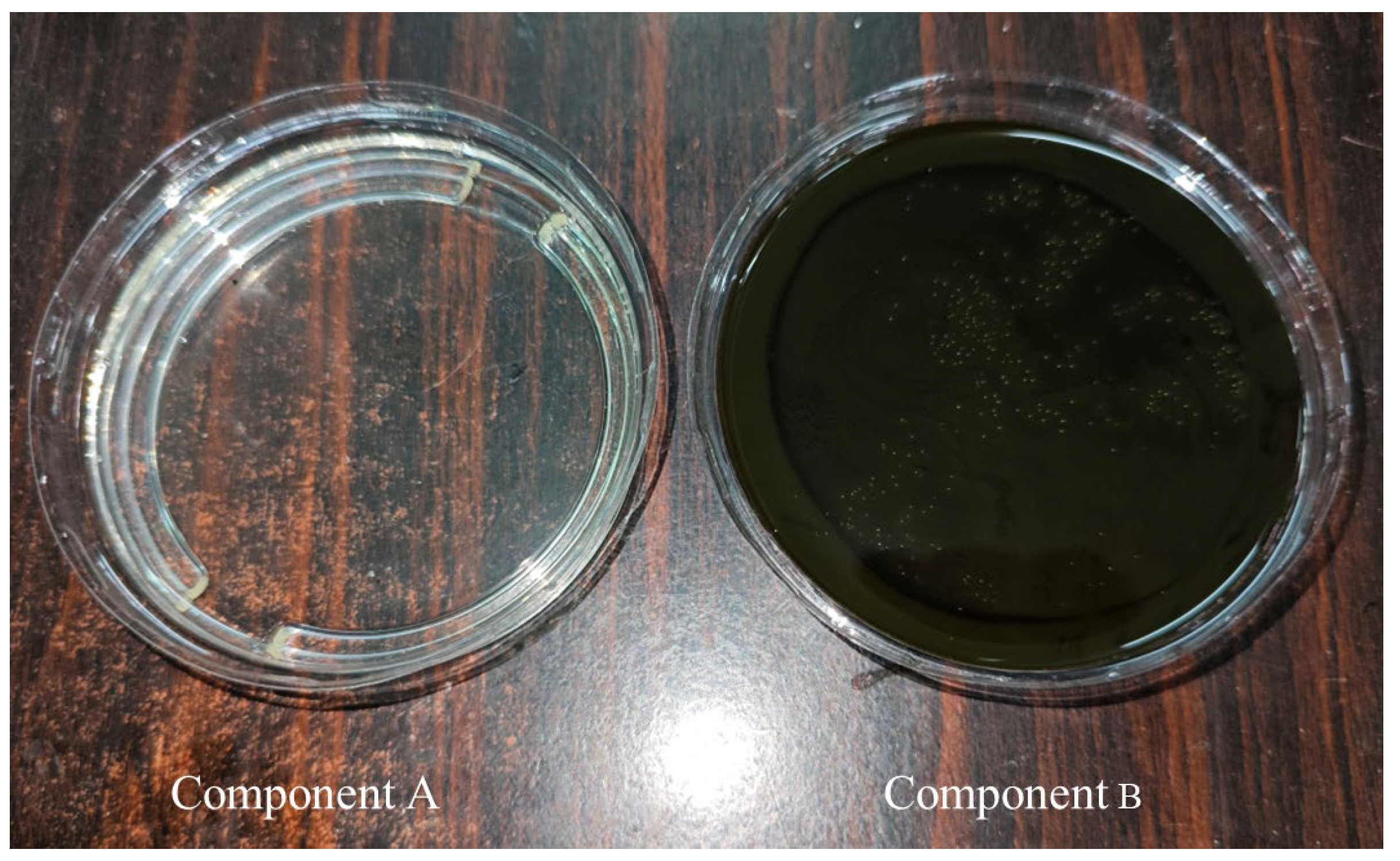
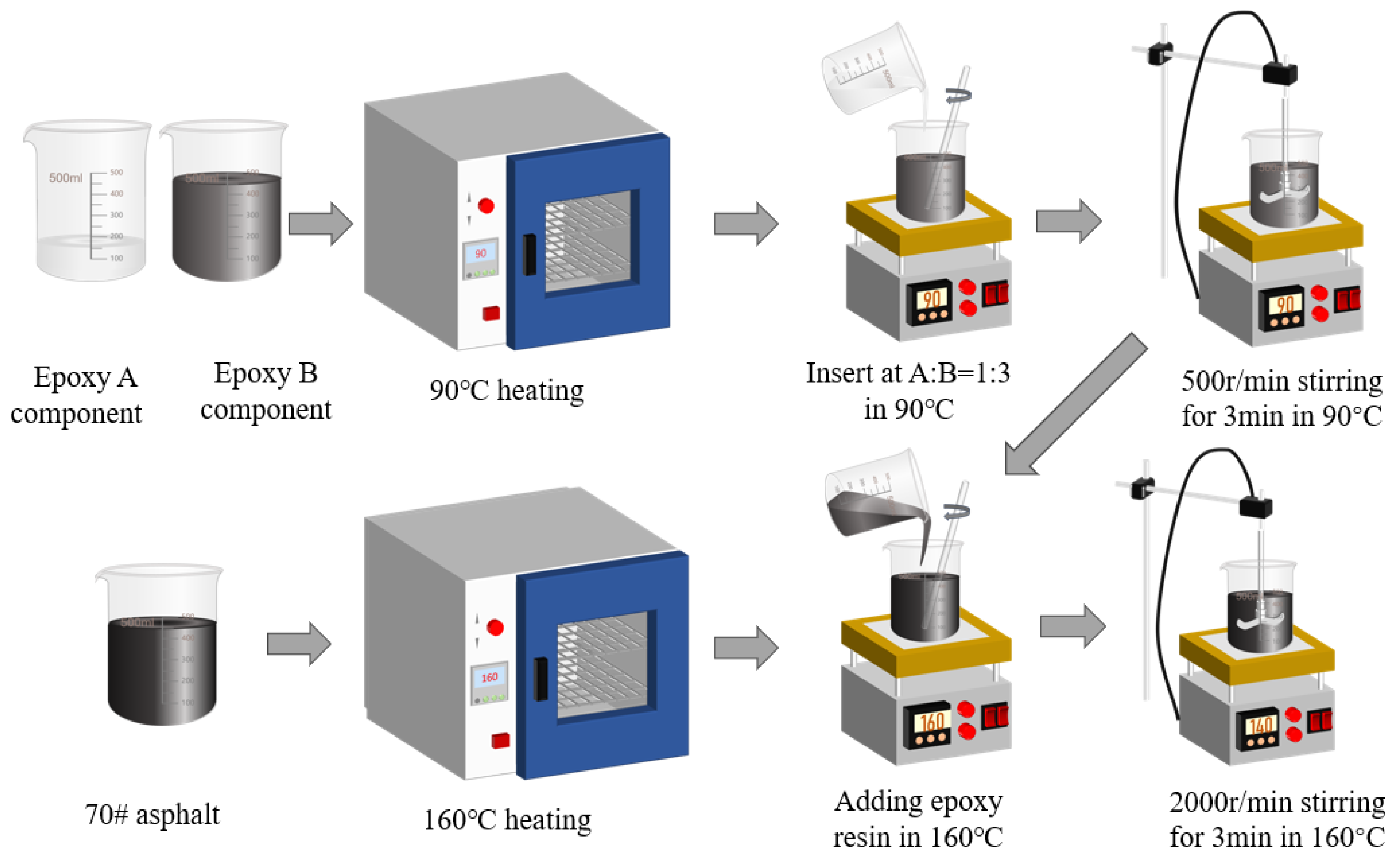

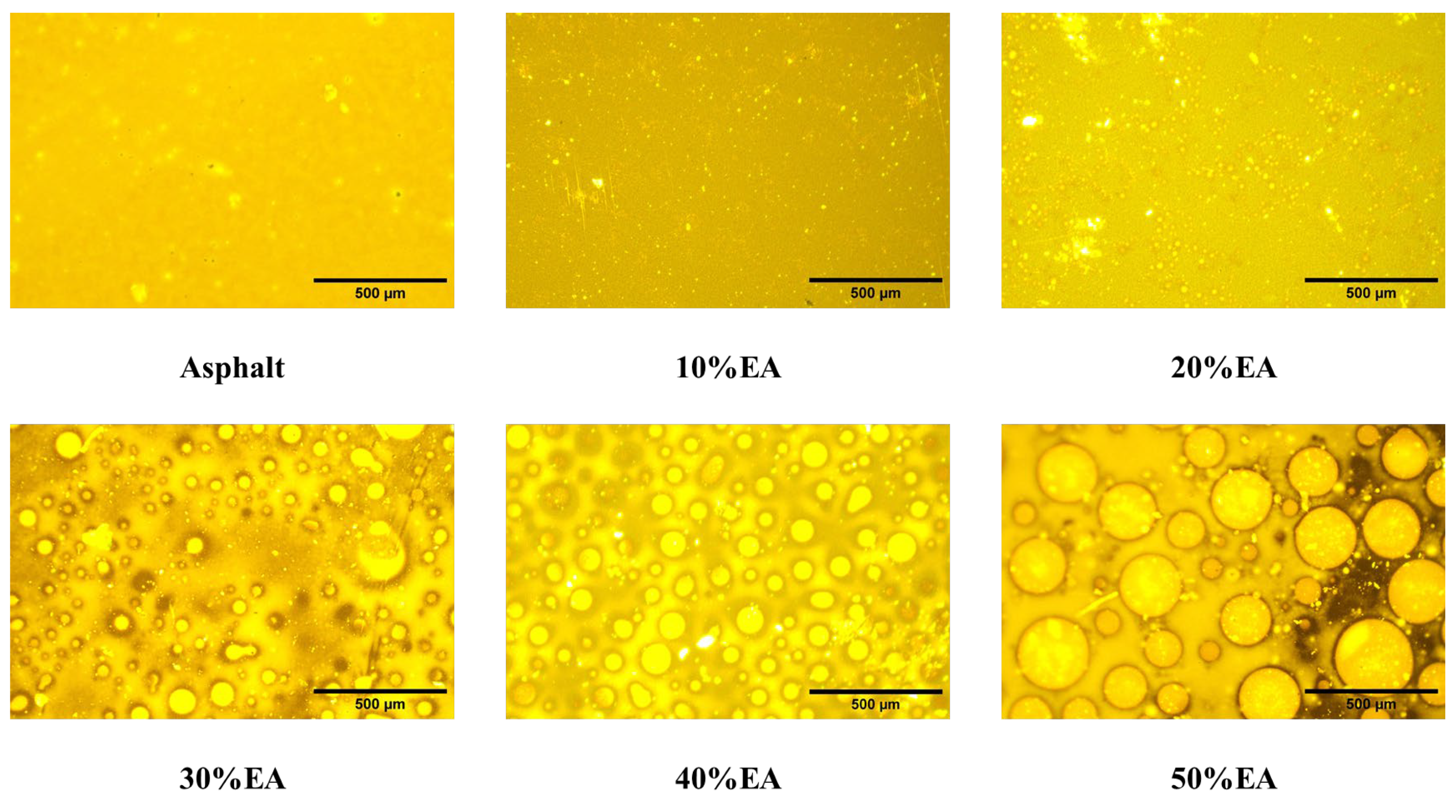
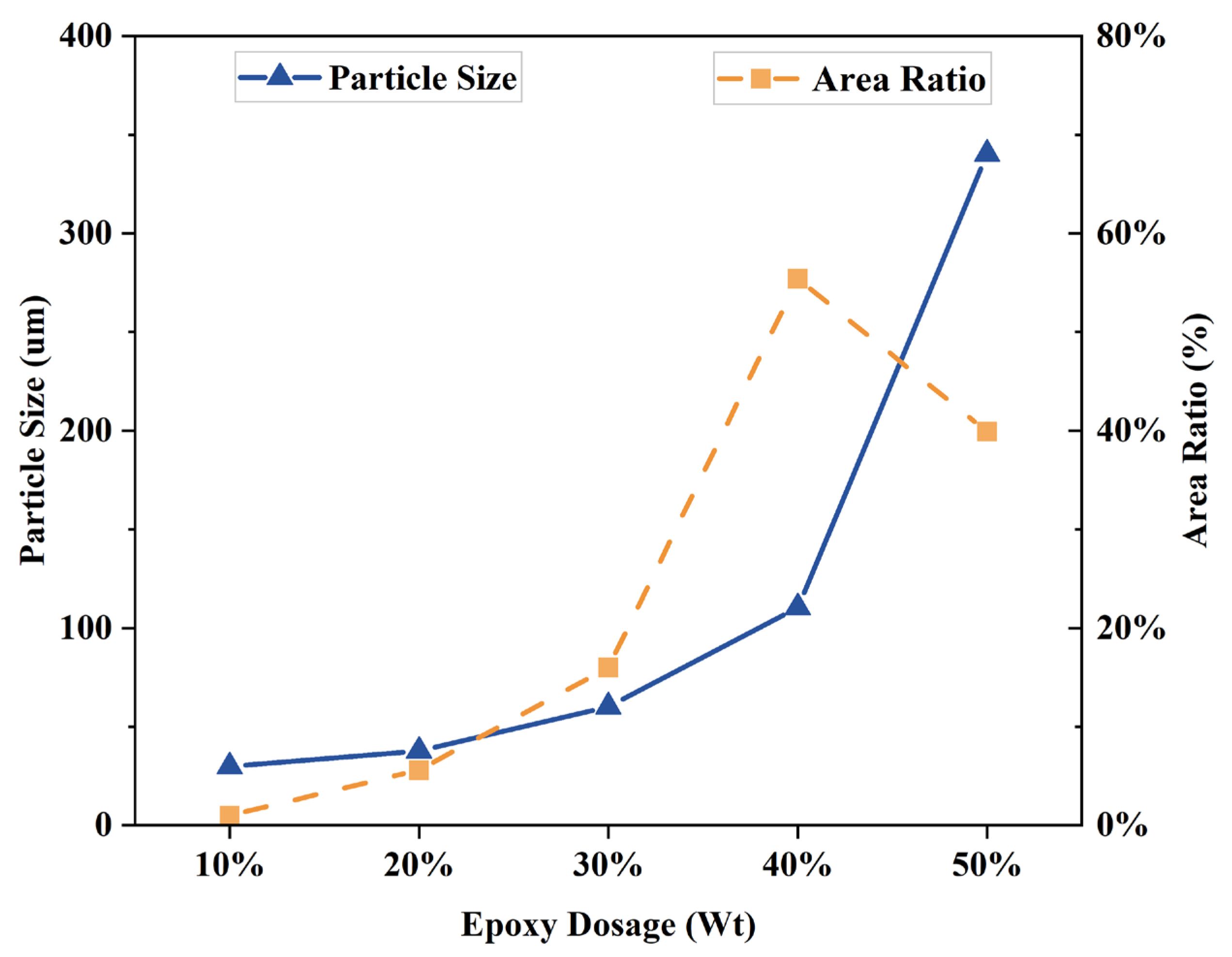
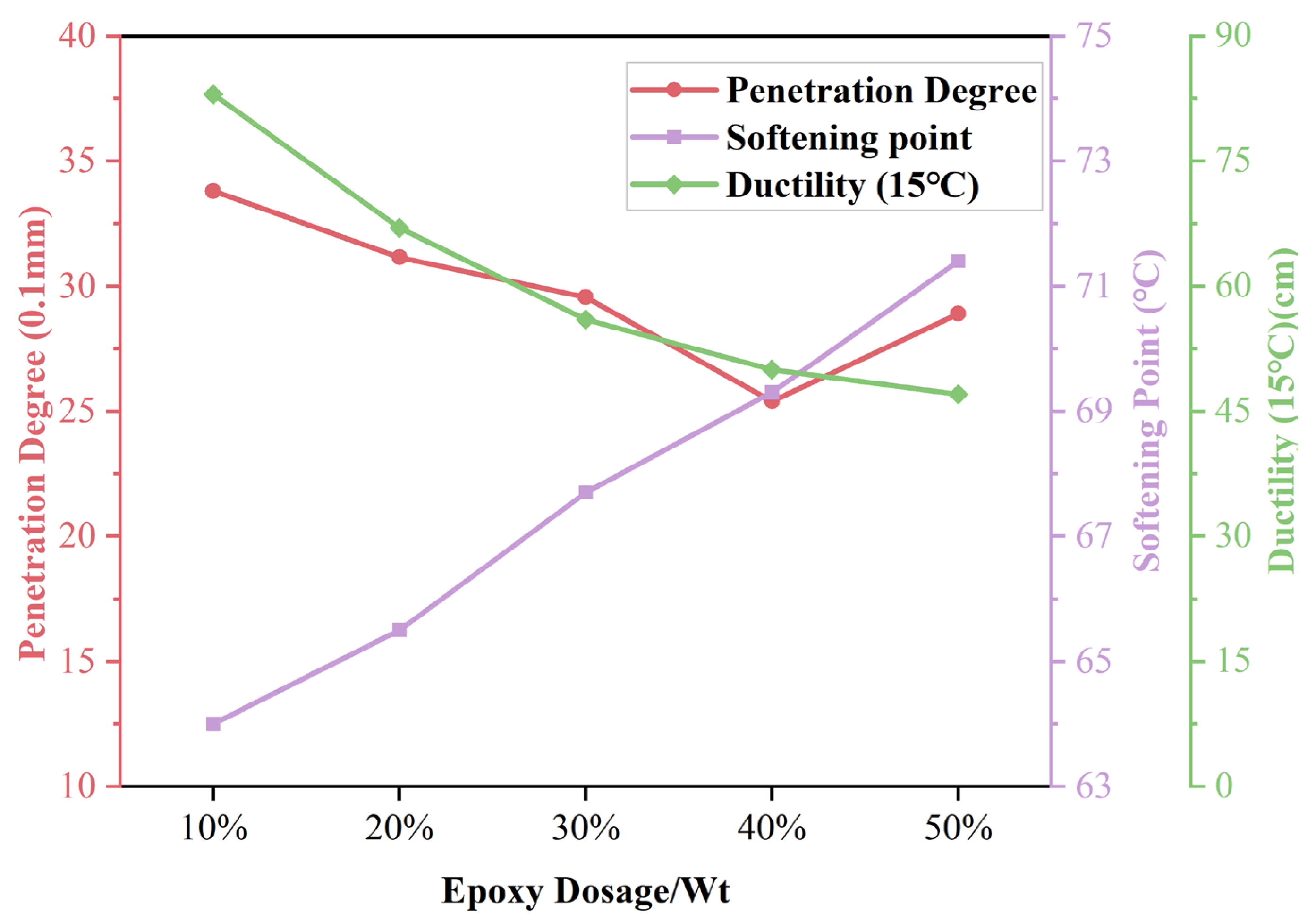
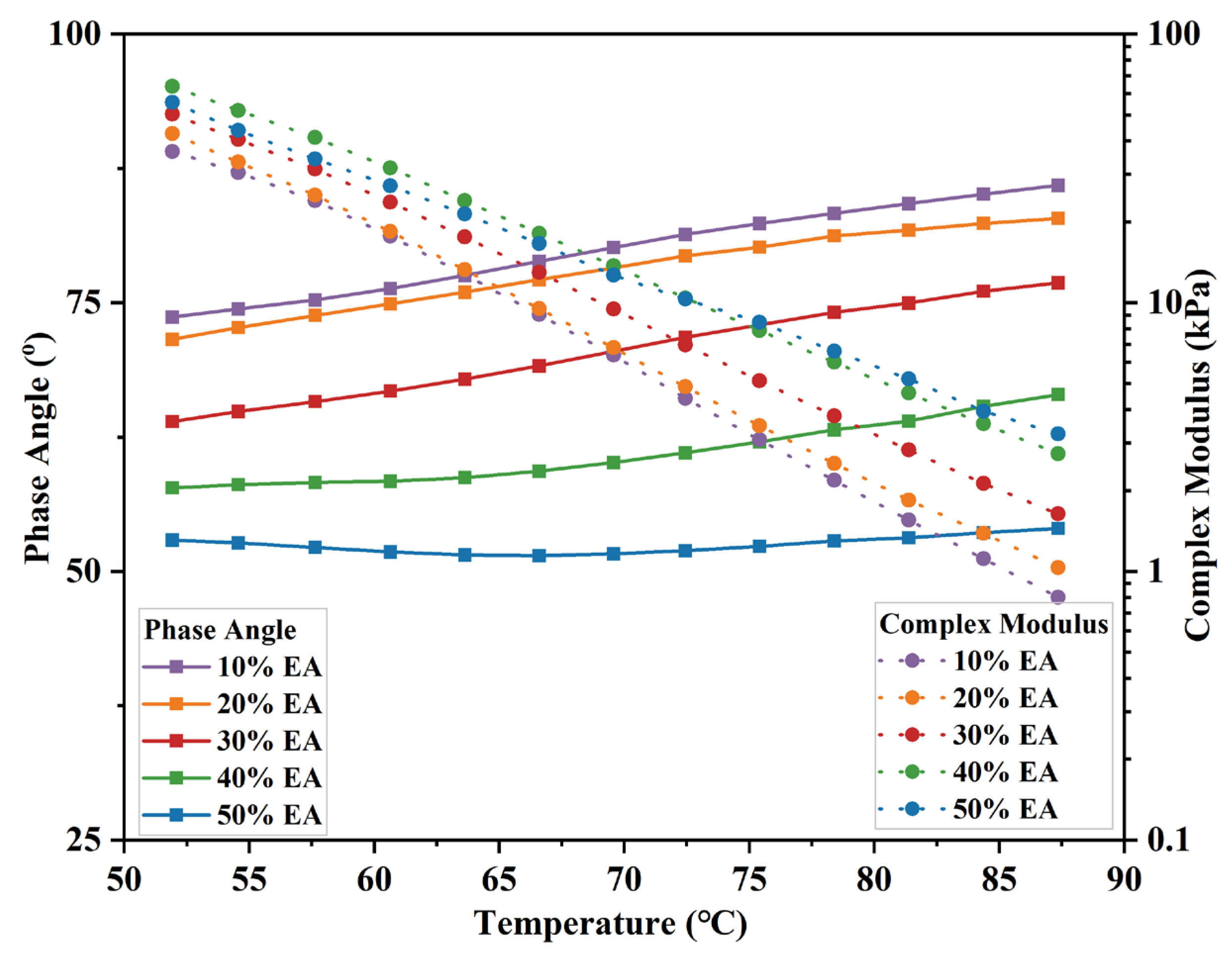

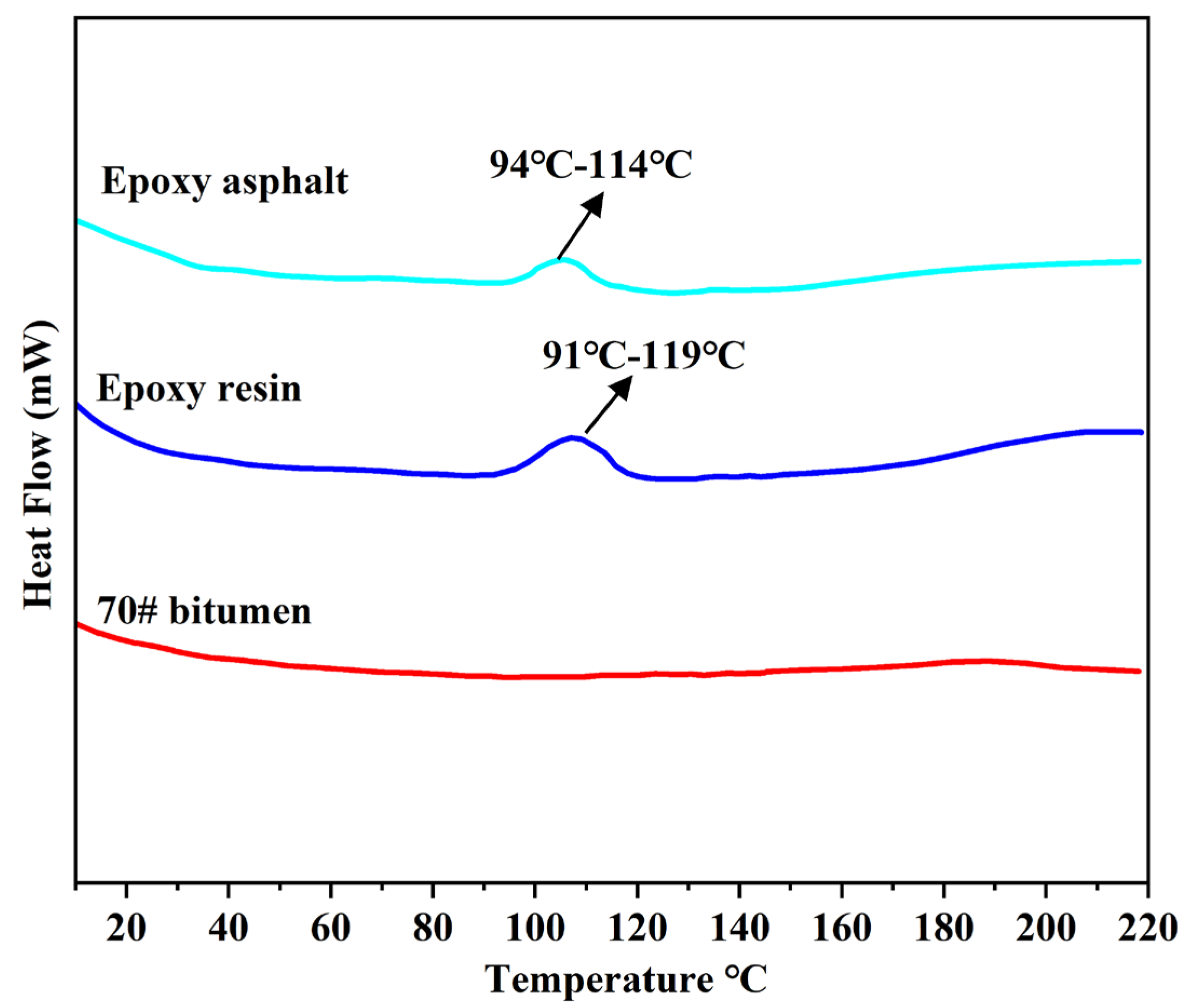

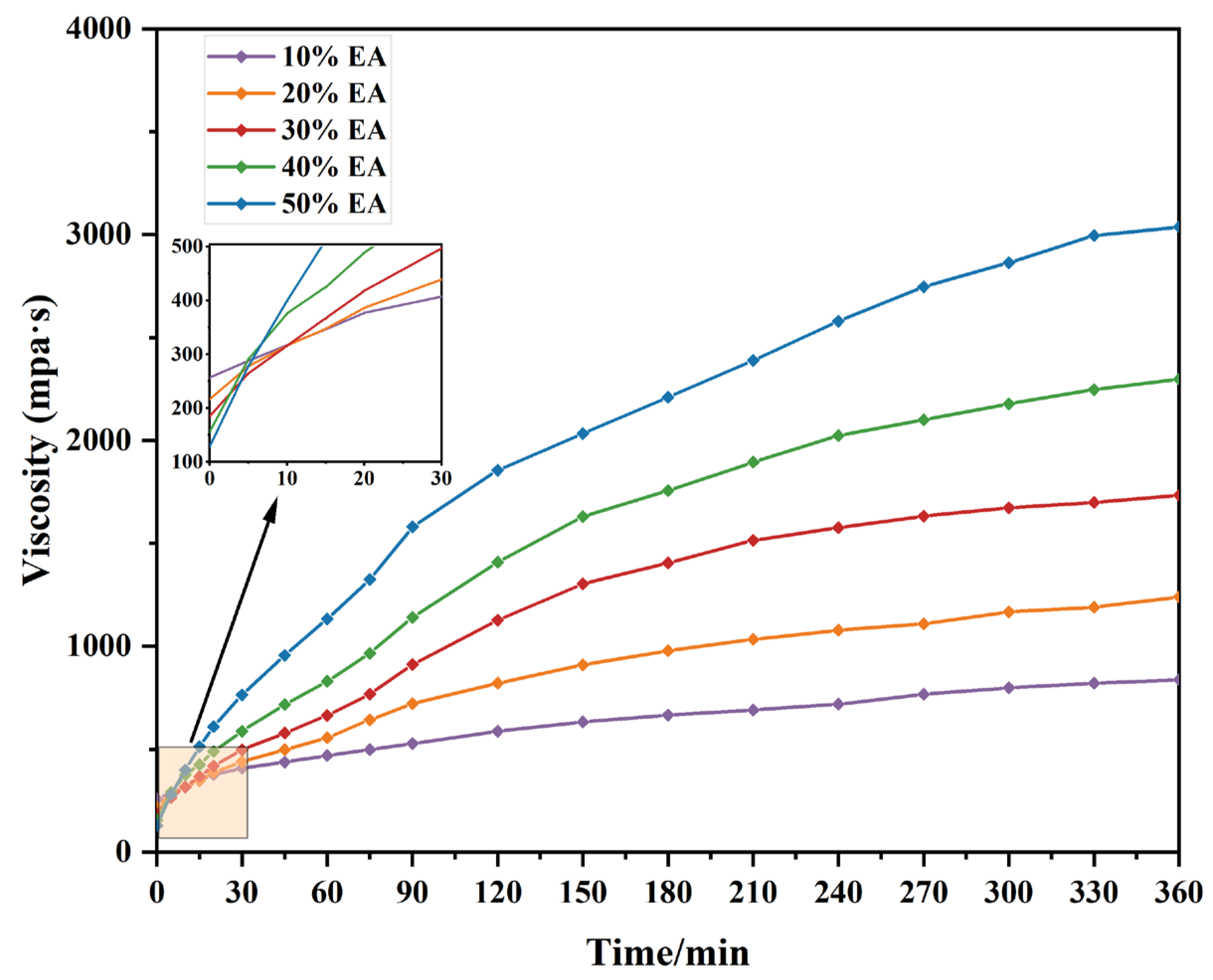
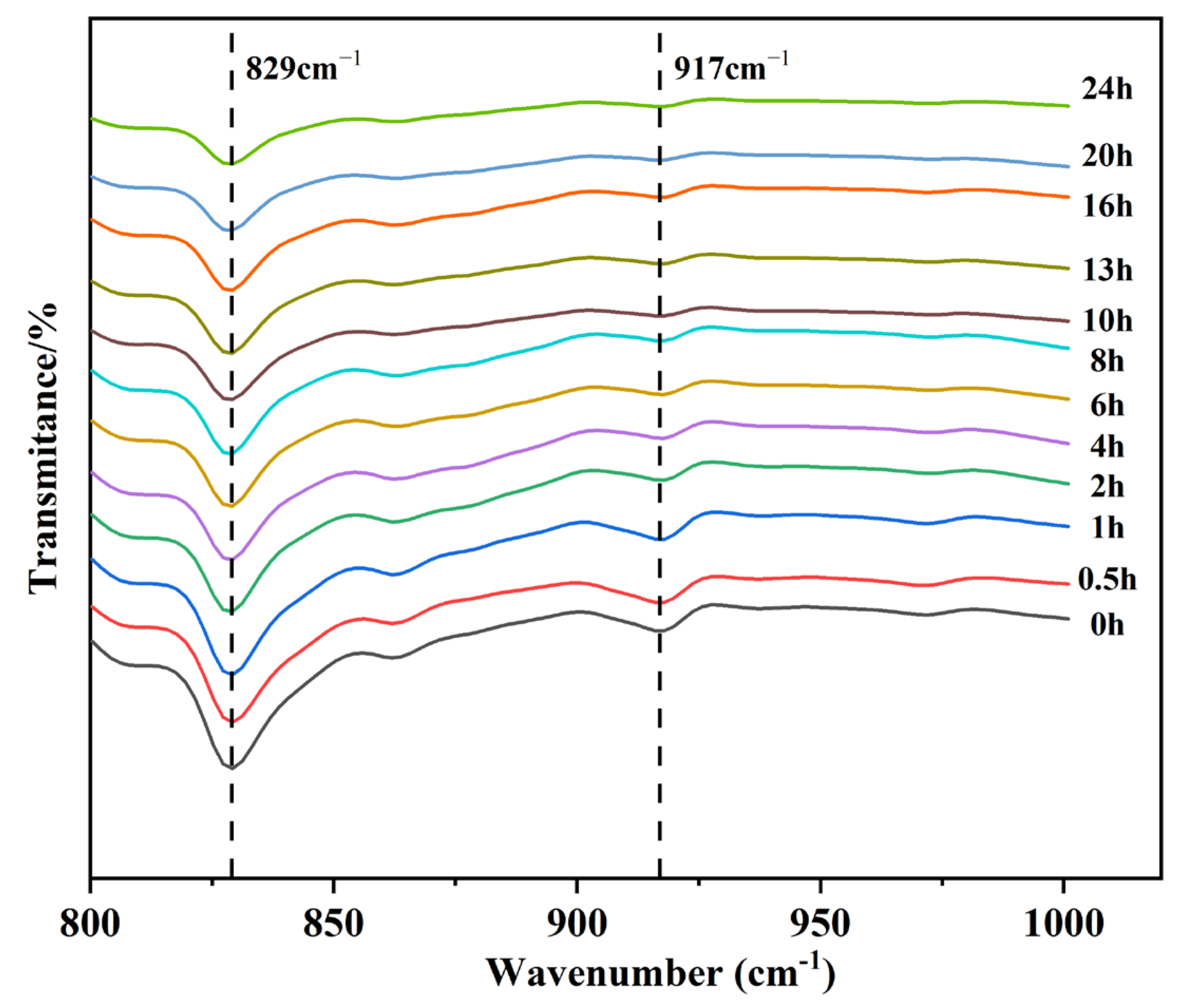

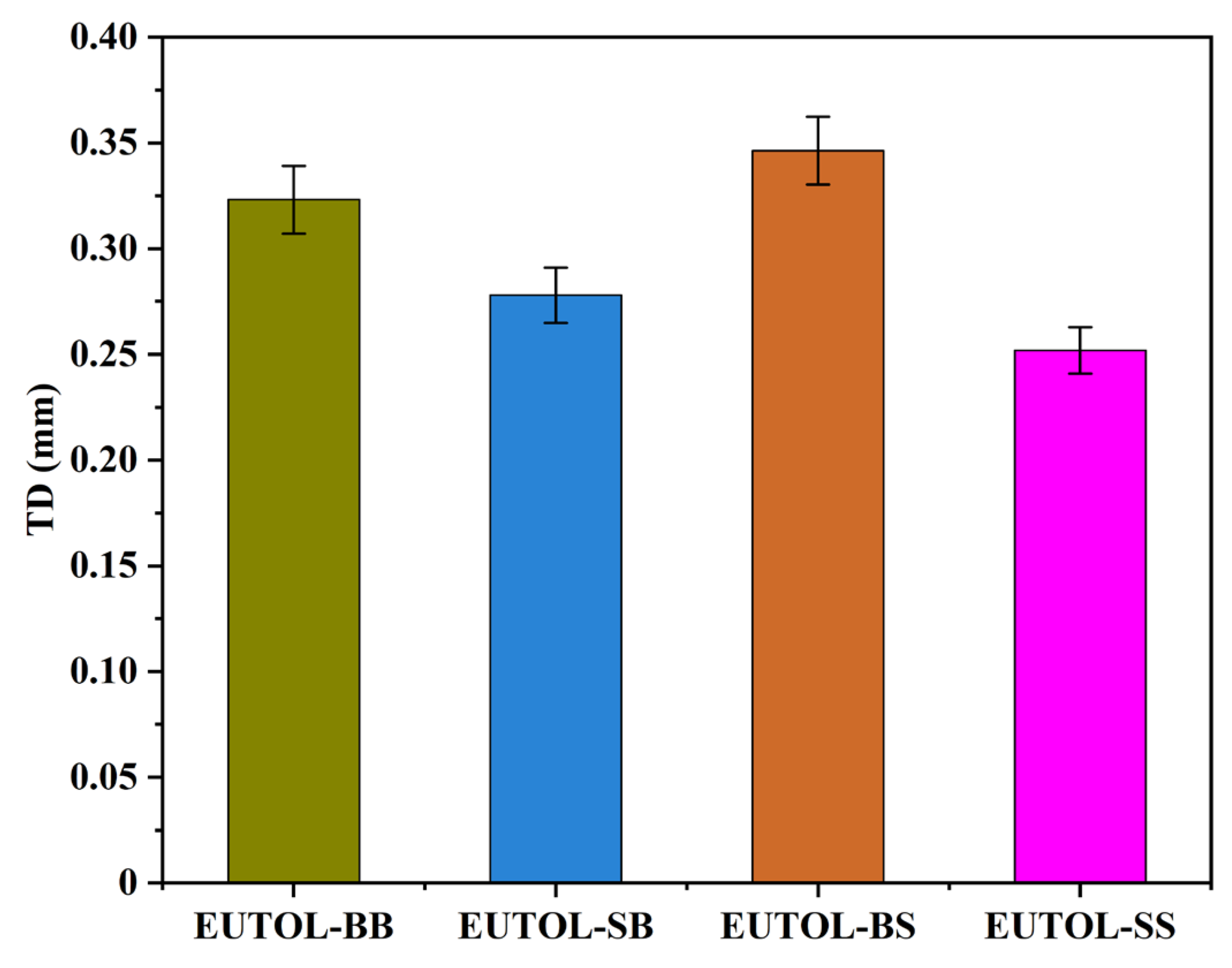


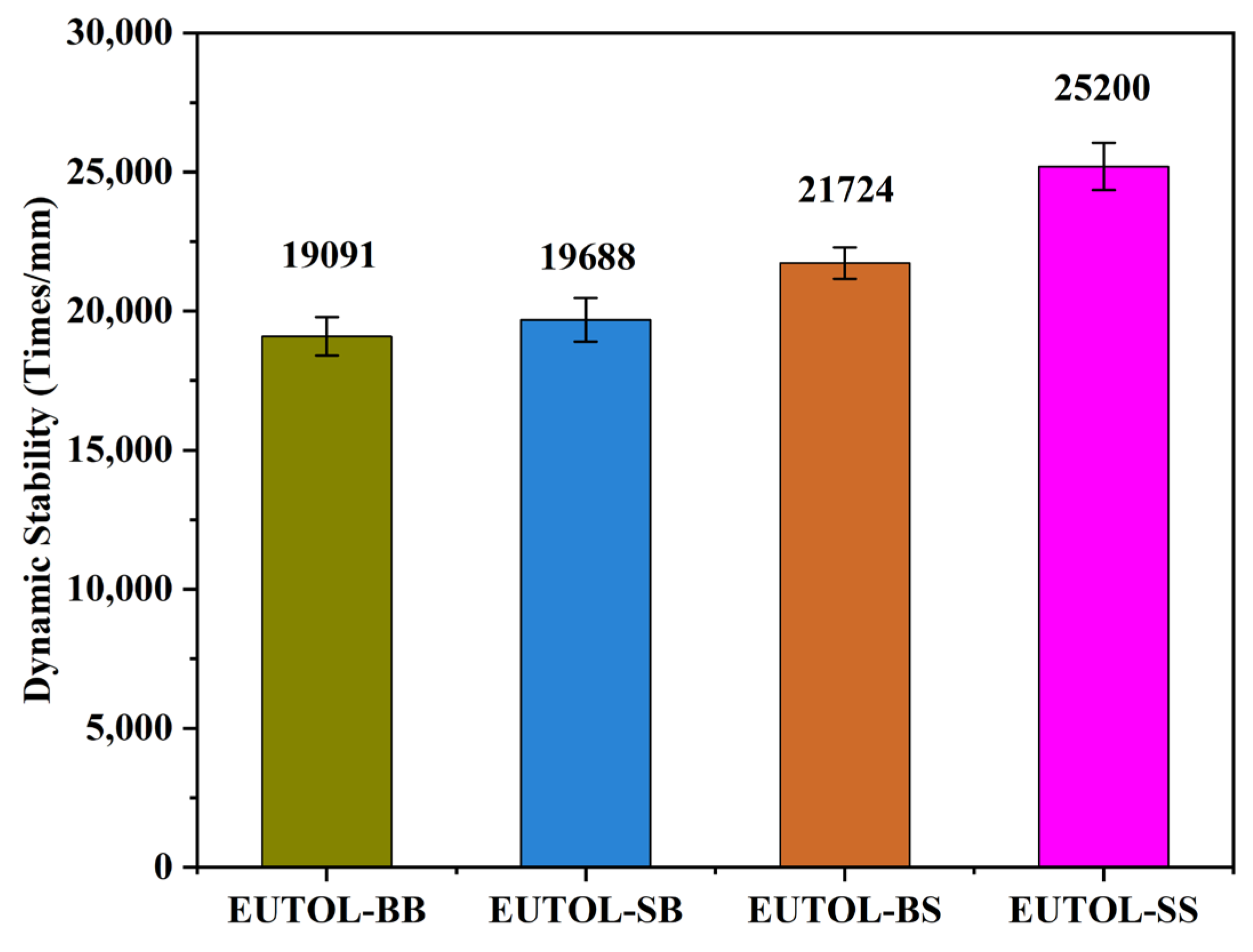
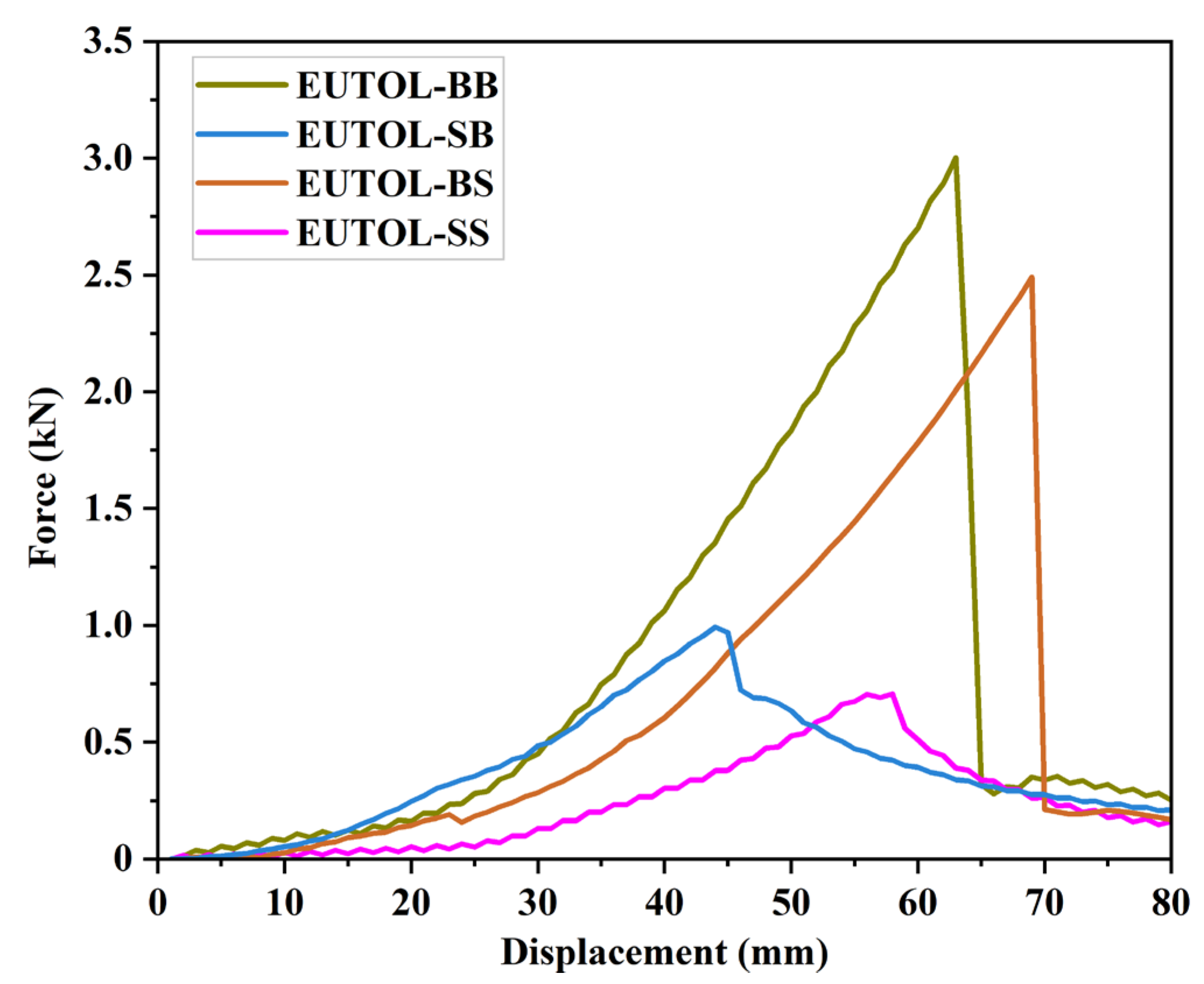
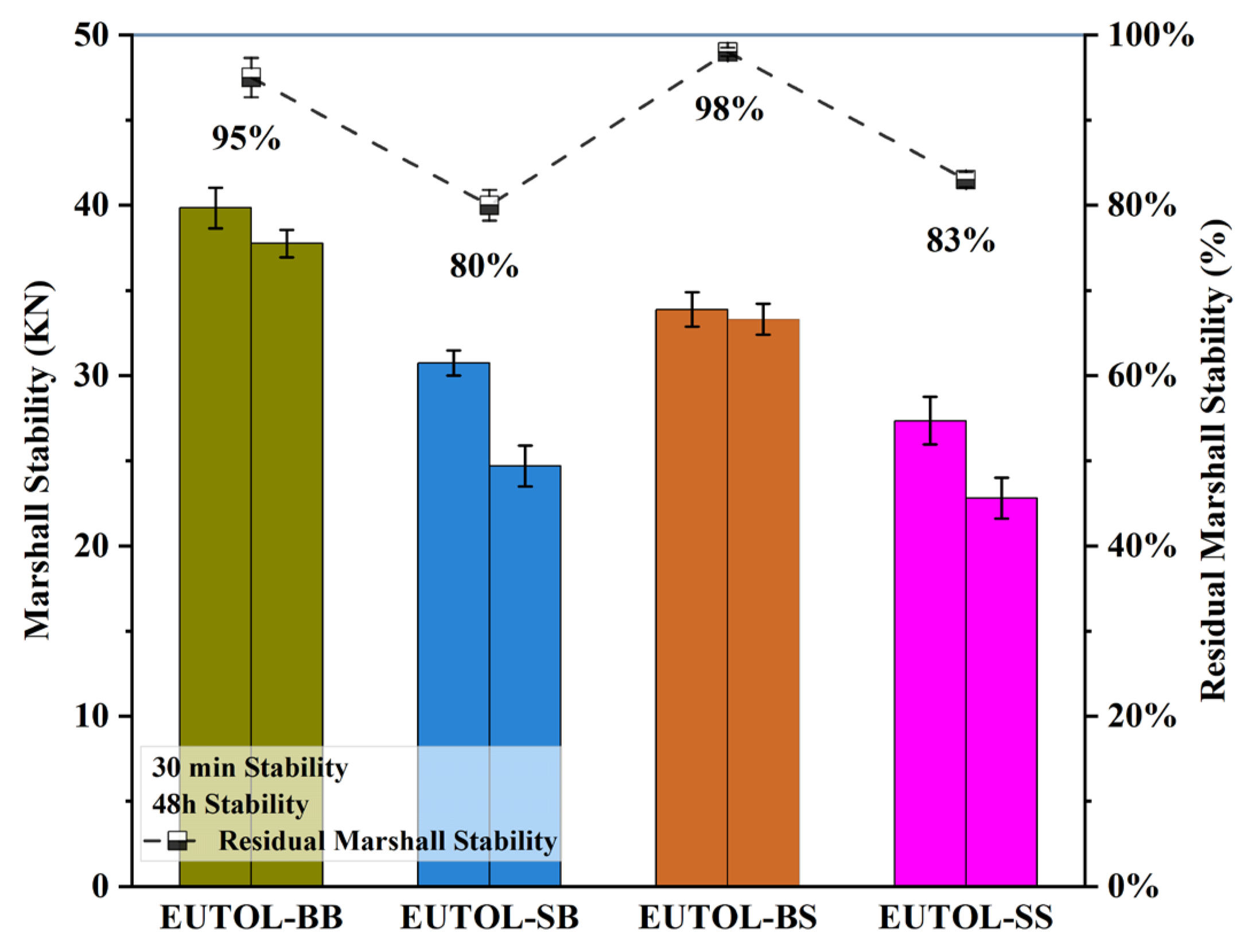
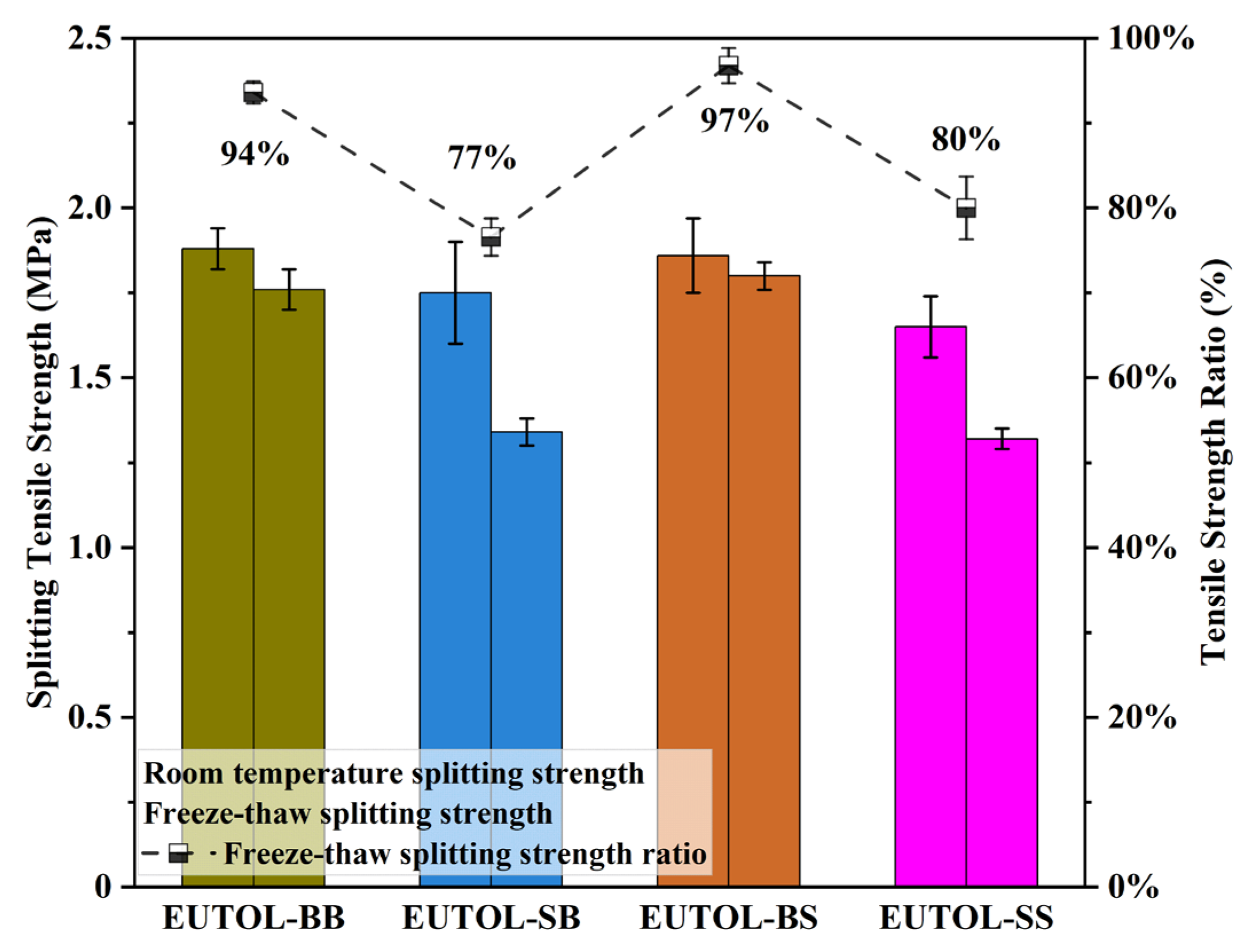
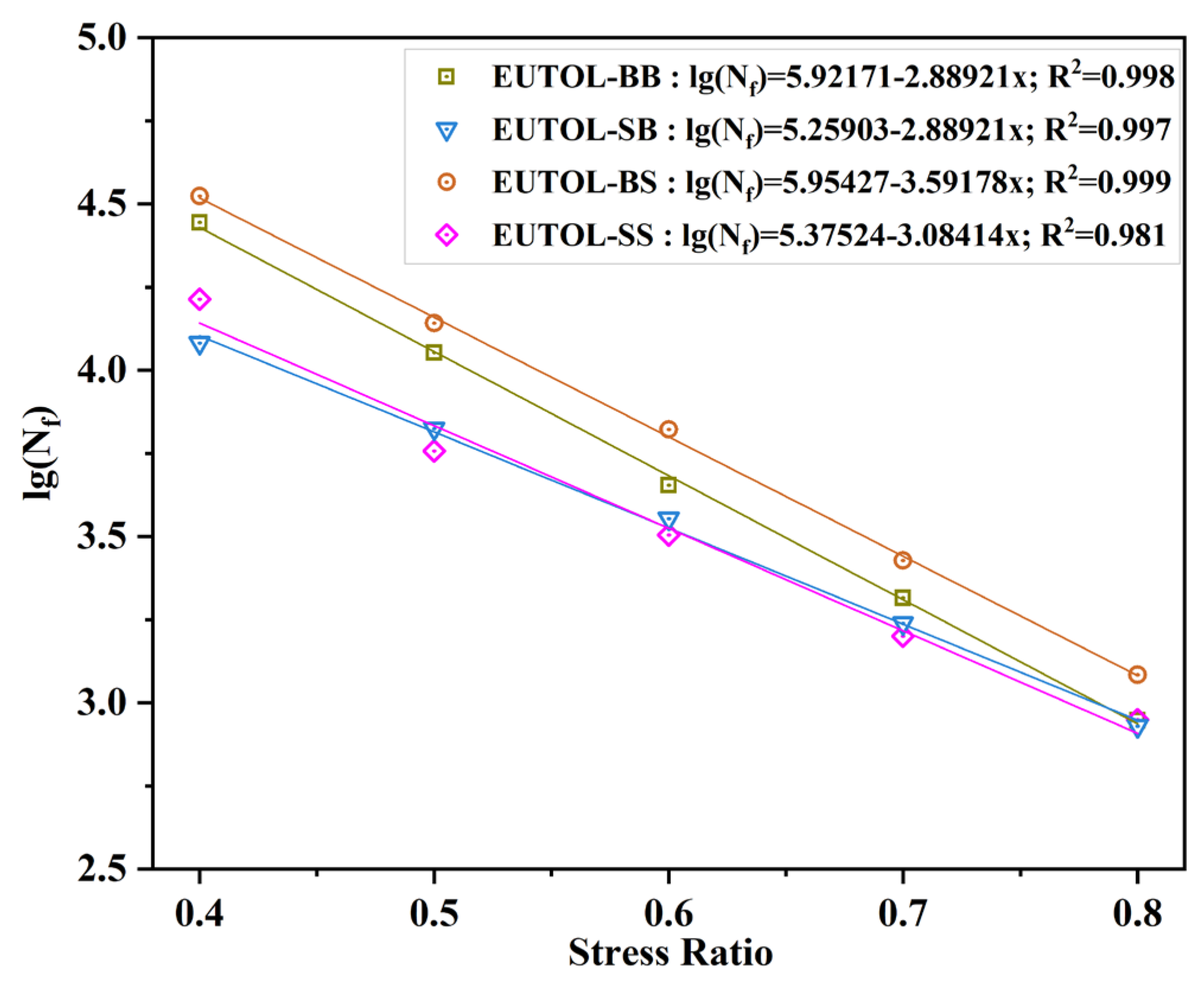
| Test Indexes | Test Results | Technical Requirements | Test Methods [37] |
|---|---|---|---|
| Penetration (25 °C, 100 g, 5 s, 0.1 mm) | 68.7 | 60~80 | T0604-2011 |
| Softening point (°C) | 48.9 | >46 | T0606-2011 |
| Ductility (15 °C, 5 cm/min, cm) | >150 | ≥100 | T0605-2011 |
| viscosity (135 °C) | 207 | ≥180 | T0607-2011 |
| Specific gravity (25 °C) | 1.039 | - | T0603-2011 |
| Test Indexes | Component A Test Results | Technical Requirements | Component B Test Results | Technical Requirements | Test Methods |
|---|---|---|---|---|---|
| Viscosity (23 °C, Pa·s) | 1.35 | 1~5 | 0.155 | 0.1~0.8 | ASTM D445 [38] |
| Epoxide equivalent weight | 187 | 190~220 | 55.2 | 180~220 | ASTM D1652 [39] |
| Flashpoint (°C) | 233 | ≥230 | 234 | ≥145 | ASTM D92 [40] |
| Specific gravity (23 °C) | 1.163 | 1.00~1.20 | 1.002 | 0.8~1.0 | ASTM D1475 [41] |
| Asphalt light component (%) | - | - | 67 | - | - |
| Appearances | Light yellow transparent liquid | - | Dark brown liquid | - | visual assessment |
| Test Indexes | Fine Aggregate | Coarse Aggregate | Technical Requirements | Test Methods [42] | ||
|---|---|---|---|---|---|---|
| Steel Slag | Basalt | Steel Slag | Basalt | |||
| Stone crushing value (%) | 12.9 | 14.2 | 12.5 | 15.6 | ≤26 | JTGE42 T0316 |
| Los Angeles wear value (%) | 15.6 | 14.1 | 11.8 | 13.3 | ≤28 | JTGE42 T0317 |
| Water absorption (%) | 1.2 | 0.92 | 1.4 | 0.86 | ≤2.0 | JTGE42 T0308 |
| Apparent density | 3.22 | 2.910 | 3.49 | 2.944 | ≥2.6 | JTGE42 T0605 |
| Test Name | Specimen | Test Temperature | Performance | Methods [37] | Photograph |
|---|---|---|---|---|---|
| Penetration | 100 g, 5 s. | 25 °C | Consistency performance | T 0604-2011 |  |
| Softening Point | 30 g | 5 °C | Shifting performance | T 0606-2011 | 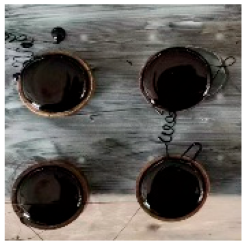 |
| Ductility | 5 g | 15 °C | Plasticizing performance | T 0605-2011 | 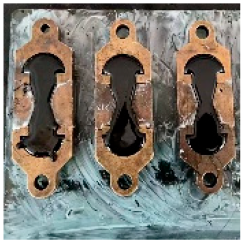 |
| Viscosity | 30 g | 110–170 °C | Viscosity performance | T 0625-2011 | 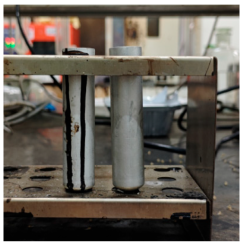 |
| Dynamic Shear Rheometer | 0.6 g | 52–88 °C | rheological performance | T 0628-2011 | 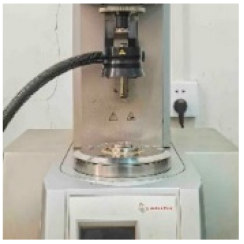 |
| Test Name | Specimen Size | Test Temperature | Performance | Methods [37] | Photograph |
|---|---|---|---|---|---|
| Texture Depth Test (TD) | 300 mm × 300 mm × 50 mm | 25 °C | Skid-resistance durability | T0962-2019 [43] | 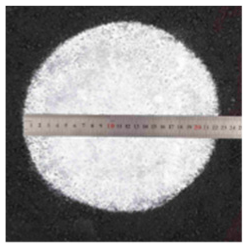 |
| British Pendulum Number Test (BPN) | 300 mm × 300 mm × 50 mm, | 25 °C | Skid-resistance durability | T0964-2019 [43] | 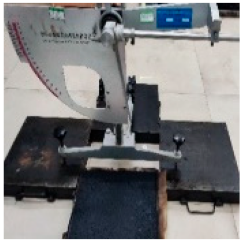 |
| Wheel tracking Test | 300 mm × 300 mm × 50 mm | 60 °C | High- temperature | T 0719-2011 | 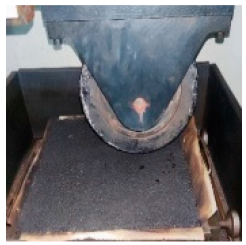 |
| Freeze–thaw Split Test | Φ101.6 mm × 63.5 mm | 25 °C | Water stability | T 0716-2011 | 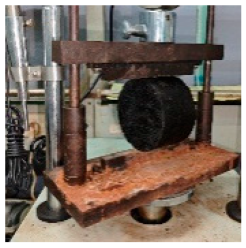 |
| Immersion Marshall Test | Φ101.6 mm × 63.5 mm | 25 °C | Water stability | T 0709-2011 | 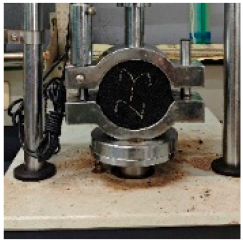 |
| Three-point bending Test. | 250 mm × 30 mm × 35 mm | −10 °C | Low temperature | T 0715-2011 | 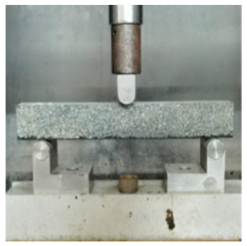 |
| Indirect tensile fatigue test | Φ101 mm, 25 mm | 15 °C | Fatigue resistance | AASHTO TP 105-2020 | 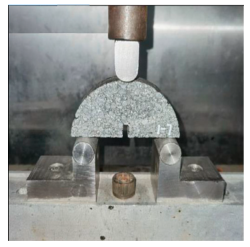 |
| The Type of Aggregate | Test Temperature (°C) | Peak Load (N) | Maximum Flexural Strain (με) | Flexural Stiffness Modulus (MPa) |
|---|---|---|---|---|
| EUTOL-BB | −10 | 3003 | 2798 | 7791 |
| EUTOL-SB | −10 | 992 | 2440 | 4348 |
| EUTOL-BS | −10 | 2492 | 3059 | 6161 |
| EUTOL-SS | −10 | 707 | 2547 | 2606 |
Disclaimer/Publisher’s Note: The statements, opinions and data contained in all publications are solely those of the individual author(s) and contributor(s) and not of MDPI and/or the editor(s). MDPI and/or the editor(s) disclaim responsibility for any injury to people or property resulting from any ideas, methods, instructions or products referred to in the content. |
© 2024 by the authors. Licensee MDPI, Basel, Switzerland. This article is an open access article distributed under the terms and conditions of the Creative Commons Attribution (CC BY) license (https://creativecommons.org/licenses/by/4.0/).
Share and Cite
Zhang, Q.; Lu, Z.; Chen, A.; Wu, S.; Feng, J.; Xu, H.; Li, Y. Study on the Performance of Epoxy-Modified Asphalt and Steel Slag Ultra-Thin Friction Course. Materials 2024, 17, 4513. https://doi.org/10.3390/ma17184513
Zhang Q, Lu Z, Chen A, Wu S, Feng J, Xu H, Li Y. Study on the Performance of Epoxy-Modified Asphalt and Steel Slag Ultra-Thin Friction Course. Materials. 2024; 17(18):4513. https://doi.org/10.3390/ma17184513
Chicago/Turabian StyleZhang, Quanmin, Ziyu Lu, Anqi Chen, Shaopeng Wu, Jianlin Feng, Haiqin Xu, and Yuanyuan Li. 2024. "Study on the Performance of Epoxy-Modified Asphalt and Steel Slag Ultra-Thin Friction Course" Materials 17, no. 18: 4513. https://doi.org/10.3390/ma17184513
APA StyleZhang, Q., Lu, Z., Chen, A., Wu, S., Feng, J., Xu, H., & Li, Y. (2024). Study on the Performance of Epoxy-Modified Asphalt and Steel Slag Ultra-Thin Friction Course. Materials, 17(18), 4513. https://doi.org/10.3390/ma17184513









